
We’ve seen our fair share of major core ranking updates this year with an update in early January, then the February 7 update, then Fred on March 7, and then more movement in late April and early May. And just a few weeks from the last update, we witnessed another big core update that rolled out on May 17, 2017.
Barry Schwartz was the first to report the update, and it wasn’t long before the impact was clear. I’ve seen substantial volatility from this update and it does look like yet another quality update. More on that soon.
Since 5/17, I’ve been digging into the update and analyzing sites that saw impact (both positive and negative). From a data standpoint, I have access to a number of sites that saw movement on 5/17, and I’ve also had a number of companies reach out to me after seeing drops or gains starting on the 17th. So there was plenty of data to dig into.
Below, I’ll describe what I’ve uncovered during my research, provide some interesting cases, along with some observations about how Google is rolling out quality updates. I’ll also cover what you can do now if you have been impacted (which shouldn’t be a surprise if you’ve read my previous posts about major core updates focused on quality).
Examples of Impact
Just like with other major core ranking updates focused on quality, I’ve seen a range of impact. For example, some sites are dropping or surging 20-30%, while others saw much more impact. And there were several that dropped heavily in early May, only to surge back on 5/17. For example, one site dropped by 83% on 5/7, only to fully recover on 5/17. It’s been fascinating to analyze cases like that (there were several).
First, here are some examples of movement based on the update:
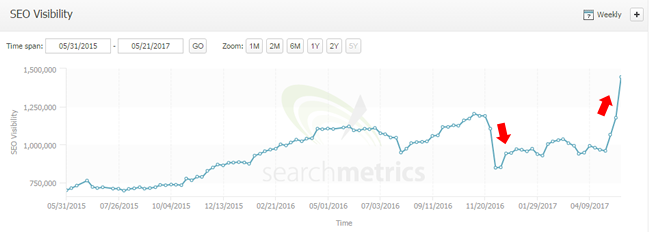
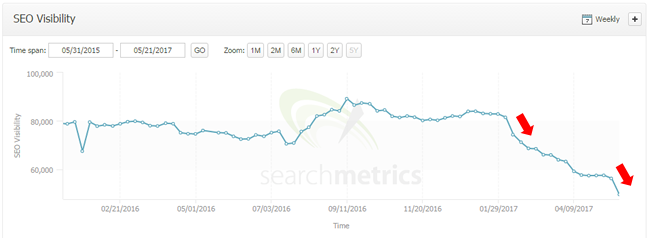

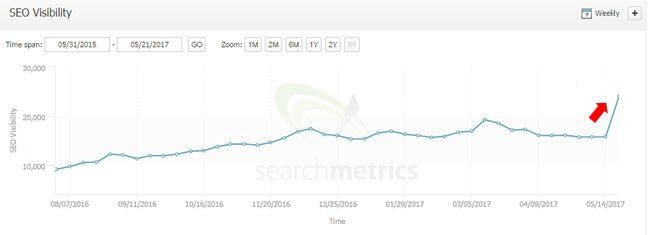

You get the picture. When the update rolled out, there was significant movement across many sites globally.
Remember, real people are visiting your site. Respect them.
After digging into many drops, I saw the usual suspects when it comes to “quality updates”. For example, aggressive advertising, UX barriers, thin content mixed with UX barriers, frustrating user interface problems, deceptive ads, low quality content, and more.
If you’ve read ANY of my posts about previous major core updates focused on quality, then what I just listed should be very familiar to you. As Google collects fresh data and refreshes its algorithms, sites drop or gain. And if you’ve been pushing the limits from a user experience standpoint, good luck.
Since Phantom 2 in May of 2015, I’ve been saying, “hell hath no fury like a user scorned”. You should get a poster of that saying and hang it in your office. Actually, hang several of them. I’m not kidding.
For example, check out this page on a site that was negatively impacted by the 5/17 update:

And on the flip side, there are sites that surged during the update that have been working hard to enhance the user experience, cut down on aggressive advertising, and boost content quality. And some have been working on this for a long time… so it’s great to see them increase during the May 17 update.
Remember, Google’s John Mueller said you need to significantly improve quality overall (and for the long-term). I’ve seen this first hand while helping companies impacted by these updates.
Side Note: Eighth Graders Know What’s Frustrating, Shouldn’t We All?
Every year I present to eighth graders at a local school about SEO, digital marketing, Google, etc. And every year I ask them if they’ve experienced any sites where it’s hard to find the content (due to ads, popups, and other aggressive monetization tactics). Well, this year they all raised their hands and groaned in agreement at the same time.
THOSE ARE YOUR VISITORS.
And Google is trying to make them (and others like them) happy. So if eighth graders know the difference between what’s acceptable usability-wise, shouldn’t we all? That includes c-level executives, monetization teams, marketing teams, and content teams.
So read the Quality Rater Guidelines, share the pdf with everyone on your team, have meetings to cover the guidelines, and internalize what Google deems low versus high quality. I’ve seen many connections between what’s contained in the QRG with what I’m seeing in the field. Beware.
Here’s a screenshot from the Rater Guidelines about distracting ads. Keep in mind, this is directly from Google:
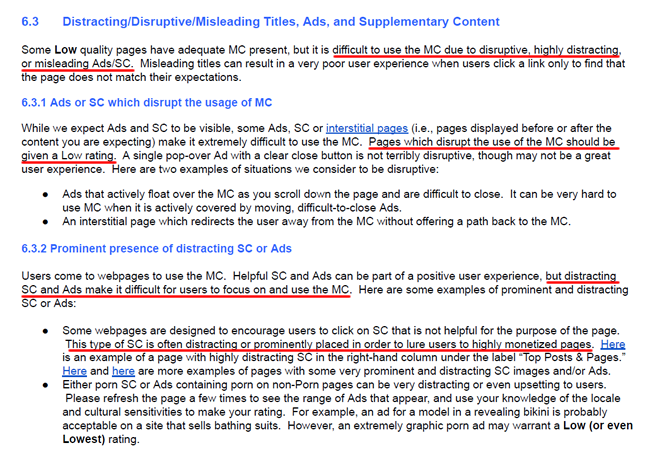
Below, I’ll cover a few interesting examples from my analysis of the update. I can’t cover everything I’ve seen or this post would be fifty pages long. So I’ve surfaced some of the more intriguing examples.
Major Reversals – Fine Tweaks or Collateral Damage?
I can’t cover this update without mentioning a very interesting case. There’s a site that was algorithmically smoked on 5/7 (around the 5/4 update) that lost 83% of its Google organic traffic overnight. Yes, 83%. It was a horrible hit, and one of the worst I have seen. After the initial hit, the company reached out to me to let me know what was going on, explained what they thought it could be, etc.
After reading about updates like this, they decided to change how sponsored links were handled across the site, and refined how advertising was displayed in general (although it doesn’t appear that their ads were overly aggressive from a UX standpoint.) Then they waited… and on 5/17, almost all of their rankings and traffic returned. Here is a screenshot of the drop and the reversal.

Now, I’ve covered how long it takes to typically recover from a major core ranking update focused on quality, and that’s usually not just a few weeks. It typically takes months. In addition, I’ve seen reversals before based on Google tweaking an algorithm to ensure we are seeing the best possible results in the SERPs. And those tweaks can sometimes yield complete reversals.
Like these reversals from past algorithm updates:


So, did the changes the company implemented after getting smoked cause the recovery during the 5/17 update or did Google simply adjust the algorithm? The only way to test this out would be to reverse their changes and see how it goes. But I definitely don’t recommend doing that… since the changes they implemented were the right ones. Anyway, just an interesting case.
Surfing the Gray Area of Quality
There was another interesting example I’ve been analyzing. It’s a site that got hammered by the June 2016 update and then surged during the February 2017 update. The site definitely did some work from an aggressive monetization standpoint, but probably just enough to creep out of the gray area. I call this “surfing the gray area of quality” because at any point, the wave could crash and you can fall back into the black.

During the May 17 update, the site lost close to 20% of its Google organic traffic. It’s in a very competitive niche and dropped in rankings for a number of important queries. So, this was clearly an adjustment after the surge in February. I’m working with them now to identify all potential quality problems, so it will be interesting to see how they progress during future quality updates.
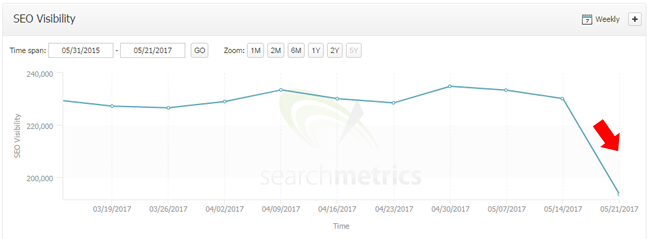
In-depth content paying off.
There’s another site I’ve helped extensively over the years that has been working hard on creating killer content on their blog. It’s an ecommerce site in a competitive niche and they decided to invest heavily in content development (including video).
During the May 2017 update, they jumped 21% overall, and the blog content really surged (jumping 37%). When checking blog versus non-blog content, you can really see the difference in the surge. So it’s interesting to see their hard work pay off from a content development standpoint.

A Splattering of Ectoplasm and a Sprinkle of Panda
When analyzing sites that were impacted, you could see relevancy adjustments show up again (just like with previous quality updates). I’ve mentioned this before in previous posts about major core ranking updates focused on quality. For example, sites dropping in rankings when their content couldn’t really live up to user expectations.
And remember, that’s exactly how Google has explained Panda ever since it became part of Google’s core ranking algorithm. Here’s a video of Gary Illyes explaining this. So, was Panda prepped again and rolled out at the same time other quality algorithms were refreshed? That’s totally possible, but hard to pin down. All I can say is that I saw relevancy adjustments many times during my travels while analyzing the 5/17 update.
Frequency of Quality Updates – Google’s quasi human is progressing…
Ever since the fall of 2016 when we saw a number of updates in a short period of time, I’ve been hinting that Google might be increasing the frequency of “quality updates”. And 2017 has followed that pattern. Here are the core ranking updates focused on quality that I have seen since the beginning of 2017:
- January 5, 2017
- February 7, 2017
- March 7, 2017 (Fred)
- April 26, 2017
- May 4, 2017
- May 17, 2017
Notice anything interesting? We’ve gone from every few months to once per month (and sometimes multiple times per month). That’s not surprising since Google’s ultimate goal is to NOT roll out updates like this at one time. Instead, I’m sure they would love to have these updates continually rolling. Yes, like Panda of the present, which is very different than old-school Panda (which rolled out on one day and caused mass hysteria).
I’m sure I’ll be covering this more in future posts, but it’s worth noting that Google is upping its game from a frequency standpoint. On the one hand, that’s great for sites that have been negatively impacted. And on the other hand, that means sites can be impacted more often (and not just every few months).
So heads-up… it’s not unusual to see impact like what’s shown below. That’s when a site sees impact during a number of quality updates (since it’s in the gray area quality-wise). That’s why it’s so important to get out of the gray area.
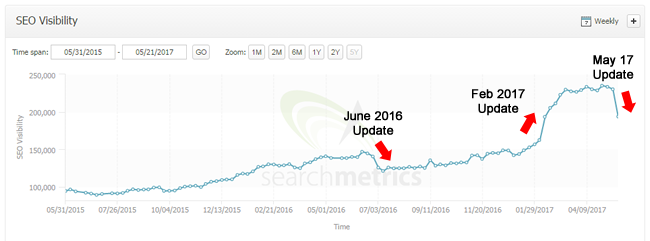
What You Can Do Now:
I’ve already covered this extensively while writing about quality updates, but I’ll list it again below. If you’ve been negatively impacted by a major core ranking update focused on quality, then:
- Analyze your site objectively from both a content quality and user experience standpoint. Run a crawl, or several, to get a solid look at your entire site. Then analyze that crawl through a quality lens.
- Improve low quality content, nuke thin content, or noindex pages that shouldn’t be in Google’s index. If they aren’t indexed, they can’t hurt you. Focus on “quality indexation”.
- Tone down aggressive advertising. If you annoy your users, Google can pick that up. And if Google sees this in aggregate, you can get smoked. Beware.
- Fix all major user experience problems on the site. Go through your site like a user would. If there are any issues that inhibit users achieving a goal, fix them. And fast.
- Hunt down technical problems that can be causing either content or UX problems. For example, major fetch and render problems, tech glitches that can cause thin content, performance problems, and more. Technical SEO is extremely important to nail down. So don’t overlook what’s under the hood.
- Continually work to add high quality content to your site. Make sure what you’re publishing is unique, relevant, and will satisfy user needs. If you can’t do that, don’t publish it. And boost the quality of content already on your site (if you feel some of it is lacking). Check the queries leading to your content and make sure it can meet or exceed user expectations. If it can’t, enhance it.
- Understand that you probably won’t recover quickly. John Mueller has said many times that Google needs to see significant improvement in quality overall, and over the long term. So keep fighting your way back. You can recover, but it’s not a sprint. It’s a marathon.
Summary – Will the frequency of quality updates continue to increase?
Based on the (new) frequency of updates, I’m wondering if we’ll see another quality update soon. Google seems to be pushing these updates monthly now (and we’ve even seen multiple quality updates per month in some cases). Again, that’s good for those that are impacted, but could be mean a lot of volatility for other sites. Stay tuned. It could be a hot summer algo-wise.
GG


Very good article – thanks
Thanks, I’m glad you found my post helpful. It was a big update with some very interesting cases. :)
Hey Glenn, what kind of sites (market/niche) were you seeing these big swings from the analysis? I know you cant’ mention sites specifically, but I’m thinking more about the niche markets or verticals (were there correlations to multiple sites in a given industry), or were these updates affecting sites across the board in a multitude of verticals?
Hi Rob. From many different sites, categories, and countries. It was a global update, so there really wasn’t a focus on specific niche categories or countries. I reviewed sites from health to ecommerce to news to entertainment (and everything in between). :)
Thanks Glenn for the in depth coverage
Thanks Boni. It was a fascinating update to analyze. And if the frequency of updates remains (or increases), I’m sure we’ll see another soon. :)
Thanks Glenn, your commitment to analyze each update has helped thousands of us to understand G changes. Thank you for all the efforts you are putting in. Also, if there is any way – we could help – do let us know.
Good stuff Glenn. Between the QRG, your analysis, and good old-fashioned common sense, there’s lots of ammunition to help SEOs guide product & development teams towards (obvious) goals of user satisfaction and error free experiences.
Appreciate your contribution to the ammo dump. Cheers
Thanks Grant. I appreciate it. And you’re right, user happiness is the goal here from Google’s standpoint. Reading the QRG (multiple times) would be a smart move for any site owner. I’m seeing many connections to the rater guidelines with what I’m seeing in the field while analyzing sites impacted. I find there are many people who still haven’t read them! Hopefully my post(s) about quality updates can help.
Another great article Glenn!
One of the sites you mentioned recovered after “they decided to change how sponsored links were handled across the site, and refined how advertising was displayed in general.”
Could you expand some more on those areas please? What did you mean specifically re: the sponsored links?
Thanks a lot!
Thanks Alex. I appreciate it. I was referring to properly nofollowing sponsored links across the site. And from an advertising standpoint, ensuring ads were not inhibiting the user experience. I’ve mentioned aggressive advertising many times in my posts about quality updates and it’s something publishers should be keenly aware of.
Intresting Article Glenn and looked for GQR to list it .
My website dropped with 30%, when I run the report of Aquisition/Landing Pages I notice an increase of Positions with 3.8% (comparing 17.05 day with 10.05 ) but the impresions are down with 30%. How this can be possible?
Hi Unik. Are you isolating Google organic traffic in Google Analytics? You should definitely do that to see the true change in sessions based on the update. Also, did you check Google Search Console to see the change in clicks and impressions based on the 5/17 update? Here’s a post of mine that explains how to do that (for all queries via Analytics Edge). https://www.gsqi.com/marketing-blog/how-to-export-queries-gsc-analytics-edge/ I hope that helps!
Thanks for sharing Glenn! Very helpful information you have here. What other tools do you use aside from Google Analytics?
Thanks Emmerey. There’s nothing better than GA and GSC (it’s data right from Google), but there are a number of other tools that are extremely helpful. For example, SEMrush, Searchmetrics, and Sistrix are excellent tools from a search visibility standpoint. I covered them in my SMX West presentation from earlier this spring. I hope that helps.
Thanks Glenn! Will check it out :)
I’ve been working on reducing ads, improving readability, content quality, etc. And it feels like it’s just a long, slow slide. Mobile traffic is insanely volatile, and desktop (where we used to do quite well) is abysmal.
Here’s an typical page, which I think provides a good experience both on desktop and mobile:
https://gamerant.com/playstation-plus-june-games-leak/
I’m actually thinking maybe it’s time to retire the mega-huge header image format. It’s SO two years ago. :)
Awesome article as usual!
Thanks Vic. I’m glad you found my post valuable! And I’m sorry to hear your site is still struggling.
But, I just checked that page and there are huge “buy now” clickable images taking up the entire length of the page (on each side of the content)! That’s really tough usability-wise and I’m sure it’s causing many people to mistakenly click them.
I would absolutely nuke those. Most people would have no idea that clicking on the side of the content would cause them to be whisked away to an advertiser site. I would categorize that as deceptive, which we know Google has called out in the Quality Rater Guidelines. I hope that helps.
I just emailed you. And I have NEVER seen anything on both sides of my page that go the entire length so I don’t know what you’re referring to. If you have a moment and could share a screen grab I’d appreciate it.
Sure, here you go. Your background is one giant ad. Users cannot escape it… they can’t scroll past it, etc. And I mistakenly clicked it several times and was whisked off to an advertiser site. Have you had this for an extended period of time? https://uploads.disquscdn.com/images/467d9ba81d07159a9b1828bb7c41c3909b7eb39c08c1080caf7c574a85aded6d.png
q(❂‿❂)p
Oh, that. That’s a site skin and it’s completely outside the content area. I thought you were talking about something on mobile. Huge sites run those all the time and I have never heard about site skins impacting google rankings and i’ve never had a complaint about one, ever, in all the years I’ve been operating websites. Popups, interstitials, etc., yes, but never on a skin.
https://uploads.disquscdn.com/images/223e8c51f822bb700e4b1308553c1bd2f2ed5a5487a8e42e59011ce8b0407e7e.png https://uploads.disquscdn.com/images/fec3e63f37c4802de4c149b89d51eac315c50c67399032943ee20c08192477b9.png
Vic, those sites are NOT employing what you are using. Those are just background images (they aren’t clickable). You have one giant ad as the background. When you click ANYWHERE outside the content, you are whisked off the site to an advertiser website. The examples you listed do not do that…
And if you’ve read any of my posts about Google’s quality updates, you should know it’s NEVER one smoking gun. It’s usually a battery of smoking guns. I often see a number of problems across sites impacted (low quality content, UX problems, aggressive advertising, etc.)
But back to the background ads, those are extremely aggressive, annoying, and deceptive. I even clicked them by accident three times while checking out the site. :)
And be careful assuming certain sites haven’t been impacted by algorithm updates. I think you would be surprised to learn about some of the large brands and powerful sites that have been hit.
Ahhh… I see the difference you’re talking about. Thanks.
Hi Glenn,
I have been searching for the last 11 days looking for answers why my site got smashed (worse that being smoked) for the May update. Although your article helped a lot in understanding, I was using a small email pop up box at the bottom right corner which has an obvious close button. ZERO advertising on the main page. Here’s the screenie :
https://uploads.disquscdn.com/images/b80c2f90064726b5076c3d9a4eca8d30868fba1518f07b39bd0860779d6bd7b7.jpg
It’s taken from my JetPack stats dashboard….
Now, what I guess is that thin content? Obviously, I am using several reviews and made one “original” review to create posts. It was doing OK then but now my site’s ranking sucks. (Although it is was and is because it just a small site).
You want to check my site for the recent posts I have made. http://www.allebookdownloads.com
Can help me point where I did wrong. As of reading your post, I just removed the email input pop up box. No other changes made.
-MER
Hi Eira.
I think you might have a number of problems with the site that could be causing issues rankings-wise. Can you email me via my contact page? Thanks.
Glenn,
Nice article, very informative. We are also having some ranking issues with Fred. We have removed the majority of our ads, removed all affiliate links plus related posts in content pages. *(I read those were an issue). Nothing seems to be effective… Can you have a look and see if I’ve missed something? http://www.shockya.com/
Hi Glenn,
great article and analyses.
Despite all those experience the shift of my website just went in the other direction.
Around the update i see a 20% uplift on my traffic- and keyword-dashboards. Now – 4 weeks later – i lost all the uplift within 2 days again and i’m nearly exactly back where i started from. Does that mean the Google Algorithm checked the website and the quality, was quite happy with it and now there was an adjustment of the algorithm again?
Thanks for your opinion!
Kind regards
Marie
Hi Troy. I highly doubt those changes in bounce rate had to do with the algorithm update, and subsequent traffic. My guess is that it’s an analytics tracking issue. Have you implemented any changes to your setup recently? For example, using event tracking. If you fire events, then those events cause GA to NOT log the session as a bounce. That’s how Adjusted Bounce Rate works (which I recommend setting up). Then bounce rate can use time on page to better represent actual bounce rate. Anyway, I hope that helps.
I know what is Rankbrain alogrithm but what is that update because I did not get quite much difference so just want to clear the doubt.